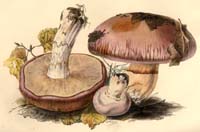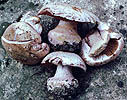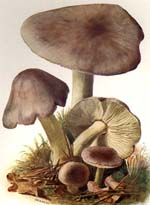Lookalikes:
Clitocybe robusta
- Cap up to 7" across; becoming pale tan; lobed and wavy in maturity
-
Spore print creamy yellow
-
Odor and taste foul
-
In woods
 Phlegmacium Subgenus
Phlegmacium Subgenus- Rusty brown spores.
-
Cobwebby partial veil.
 Sericeocybe Subgenus
Sericeocybe Subgenus Key to Gilled Mushrooms Key
Key to Gilled Mushrooms Key Agaricales Order
Agaricales Order White Spored Suborder
White Spored Suborder Tricholomataceae Family
Tricholomataceae Family Terrestrial Trich Subfamily
Terrestrial Trich Subfamily Woodland Normal Trich Tribe
Woodland Normal Trich Tribe Clitocybe-like Fungi Subtribe
Clitocybe-like Fungi Subtribe Clitocybe Genus
Clitocybe Genus
 Clitocybe nuda
Clitocybe nuda Clitocybe saeva
Clitocybe saeva




